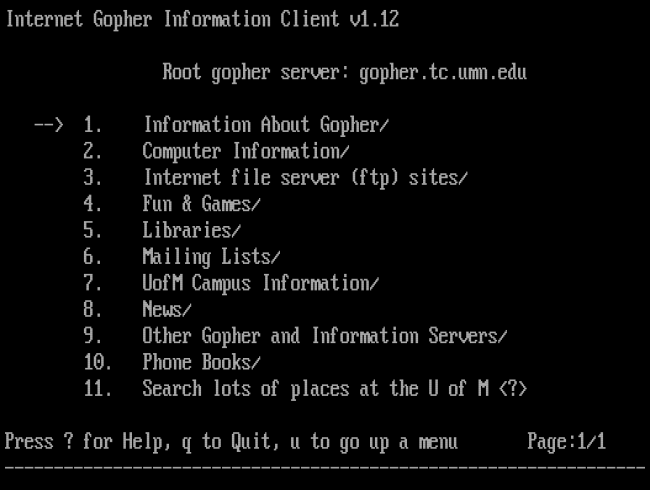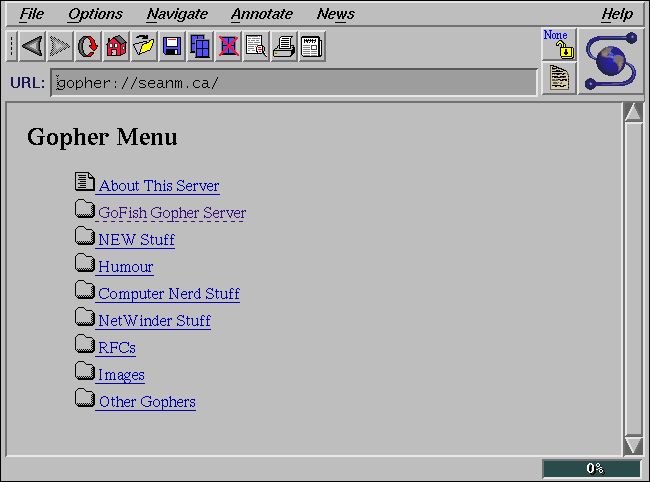Quick Links
Before the rapid growth of the World Wide Web in the 1990s, a protocol called Gopher briefly made the internet easy to use by combining the world's online resources. Here's what made it special---and why it was quickly eclipsed by the web.
What Is Gopher?
Gopher is a client/server directory system that launched in 1991. It allowed people to quickly browse resources on the internet. When you used a Gopher client, you would see a hierarchical menu of links that either led to documents, telnet-based applications, FTP sites, or other Gopher servers. You could also search across "Gopherspace" to find documents instead of hunting through FTP servers one by one.
A group of programmers---led by Mark P. McCahill, and including Farhad Anklesaria, Paul Lindner, Daniel Torrey, and Bob Alberti---created Gopher while working for the University of Minnesota's microcomputer support department.
They were tasked with creating a campus-wide information system based on ambiguous guidance from administrators, who had a preference for large mainframe computers. In a rebellious turn, the crew developed a lightweight, distributed approach that used inexpensive personal computer hardware instead.
The developers called their new system "Gopher" ("Golden Gophers" is the name of the university's sports team) to win support from their skeptical bosses.
"How could they argue with that?" said McCahill, who spoke with How-To Geek via telephone.
Gopher is also a homonym for "gofer," meaning someone who fetches things for others, which is exactly what the Gopher system was designed to do.
Internet Resources Were Now Easier to Find
Prior to Gopher, people usually retrieved documents and programs from the internet one by one via various FTP servers located around the world. There were also custom text-based Telnet applications, such as library card catalogs, student directories, database interfaces, and MUD games. However, there wasn't a unified system to bring all of these resources together.
Because it combined all these internet resources in a user-friendly way that didn't require any data input into a centralized, structured database, Gopher was a real breakthrough. You could search across Gopherspace or just browse a Gopher system through a series of menus and see where it led.
Gopher was also flexible enough to suit the needs of other organizations seeking a similar system. So when the University of Minnesota publicly released the Gopher software for free, its usage grew quickly around the world.
"We had the right, simple solution to a need that was becoming general," said McCahill.
Gopher's Popularity Predated the Web
Another internet technology, the World Wide Web, also debuted in 1991. It was created by Tim Berners-Lee at CERN in Switzerland.
Like Gopher, a WWW client (which we now call a web browser) could pull together decentralized internet resources from around the world. Unlike Gopher, though, the WWW used a document-centric model.
Rather than a hierarchical menu, each server delivered a series of text documents peppered with hypertext links to connect them. It was one more step toward decentralizing document and file distribution. However, the WWW's utility in a text-based, online world mostly accessed through serial terminals wasn't immediately obvious.
When the WWW first launched to the public in August 1991, it didn't make much of a splash. McCahill knew Berners-Lee from conferences and reviewed the WWW technology, but dismissed it as unimpressive at that stage.
Meanwhile, Gopher quickly gained a foothold among academic and government institutions, which were the primary users of the internet at that time. It quickly became a killer app at the front-end of university library systems, which relied heavily on structured data.
The internet was almost completely noncommercial at that point.
"When we were doing Gopher," explained McCahill, "there were secondary use policies that you can't do commercial activity on the National Science Foundation net that linked all the universities together. So, there were prohibitions against doing commercial stuff."
In this structured, not-for-profit realm, Gopher thrived. Due to the limited bandwidth, the internet wasn't yet a multimedia experience, so Gopher was the perfect tool for exploring the early, text-based version.
Even by 1993, when the internet became large enough to garner attention outside of academic and research circles, many in the press touted Gopher as the most established, user-friendly element of it.
The Web was not yet considered the premier internet technology, although that changed very rapidly.
How the World Wide Web Surpassed Gopher
Throughout 1992-93, Gopher rapidly gained popularity. The original core team of developers, along with some volunteers, continued its development and maintenance, but they were soon overwhelmed.
To offset costs, the university decided it would start charging a licensing fee for every for-profit Gopher server in use. This decision was met with confusion and protests. It tarnished Gopher's name and marked the beginning of the end of its growth.
Meanwhile, the WWW grew exponentially in popularity as its technologies continued to evolve. In 1993, NCSA released Mosaic, the first web browser with in-line graphics support, which coincided with the widespread adoption of Windows on consumer PCs. Unlike Gopher, which mostly collected and organized resources, the WWW was a publishing platform. With graphics now in the mix, the WWW could easily be adapted for commercial use.
Gopher's incredible popularity with libraries early on put the team on the wrong track. They imagined gathering all the world's noncommercial information resources into a unified system.
"What was actually happening in a lot of people's heads was not, 'I want to go to the library,'" said McCahill. "It was, 'Hey, this is a platform for advertising and business.' We didn't get that until a little bit too late in the game."
They didn't realize how quickly the WWW would be adopted for commercial purposes, which drove its rapid growth among businesses and the general public. By the time this dawned on the Gopher team, it was too late for Minnesota's upstart protocol. Its server growth started to stagnate around mid-1994, just as the WWW exploded.
The final nail in the coffin might have been that new web browsers, like Mosaic, natively supported the Gopher protocol. This made Gopherspace feel like a subset of the WWW platform. You could also easily create menus of links on a web page, so, at that point, Gopher couldn't do anything the WWW could not.
The Web's Success Comes with a Price
As the WWW overtook Gopher, Berners-Lee also became a well-known figure, on par with other great inventors. He was even awarded a knighthood in 2004. Meanwhile, McCahill continued his relatively low-key, but distinguished, academic computing career and now works at Duke University. He thinks the WWW's success was inevitable due to its commercial nature, and he's okay with that.
Other internet pioneers---like Mosaic creator, Marc Andreessen---vaulted from academia to Silicon Valley to follow the money trail. McCahill, however, is happy with the path he chose:
"I looked at it and went, 'You know, I'm actually more happy doing stuff that's in service of research and education than trying to get super-rich selling ads."
Berners-Lee chose the path of public service, as well, but McCahill noted that the success of the WWW placed a heavy burden on his shoulders.
"Maybe that's another reason I'm okay with the web beating out Gopher," McCahill said. "I don't have things like Facebook and its weaponized surveillance platform on my conscience directly."
It's true that the next layer of internet innovation---social media---completely reshaped our society.
"None of the people who invented this technology are happy with how the social media played out," McCahill said.
It's Not Completely Dead
Believe it or not, there are still Gopher servers on the internet, but they're mostly run for nostalgia. Because modern browsers don't support the protocol, you'll also have to get a stand-alone client or browser plugin to explore Gopherspace.
A great place to start is the Overbite project, where you'll find Gopher plugins for many modern web browsers and even a client for Android phones. The best server to check out first is
gopher://gopher.floodgap.com
.
Have fun in Gopherspace!



